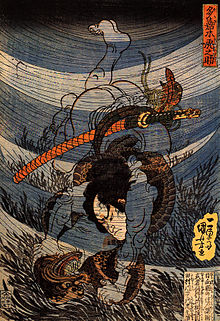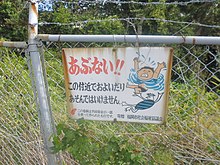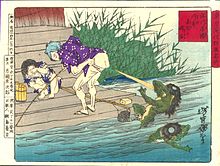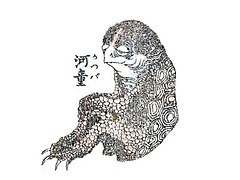|
Kappa (folklore)
In traditional Japanese folklore a kappa (河童, "river-child")—also known as kawatarō (川太郎, "river-boy"), komahiki (駒引, "horse-puller"), with a boss called kawatora (川虎, "river-tiger") or suiko (水虎, "water-tiger")—is a reptiloid kami with similarities to yōkai. Kappa can become harmful when not respected as gods. Accounts typically depict them as green, human-like beings with webbed hands and feet and turtle-like carapaces on their backs. A depression on the head, called a "dish" (Japanese: sara), retains water, and if this is damaged or its liquid is lost (either through spilling or drying up), a kappa becomes severely weakened. The kappa favor cucumbers and love to engage in sumo-wrestling.[1] They are often accused of assaulting humans in water and removing a mythical organ called the shirikodama from their victim's anus.[2] Terminology The name kappa is a contraction of the words kawa (river) and wappa, a variant form of 童 warawa (also warabe) "child". Another translation of kappa is "water-sprite".[3] The kappa are also known regionally by at least eighty other names such as kawappa, kawako, kawatarō, gawappa, kōgo, suitengu.[4] It is also called kawauso 'otter', dangame 'soft-shelled turtle', and enkō 'monkey', suggesting it outwardly resembles these animals. The name komahiki or "steed-puller" alludes to its reputed penchant to drag away horses.[4] The kappa has been known as kawako in Izumo (Shimane Prefecture) where Lafcadio Hearn was based,[5] and gatarō was the familiar name of it to folklorist Kunio Yanagita from Hyōgo Prefecture.[6] Appearance  Kappa are said to be roughly humanoid in form and about the size of a child, inhabiting the ponds and rivers of Japan.[1] Clumsy on land, they are at home in the water, and thrive during the warm months.[7] They are typically greenish in color[8] (or yellow-blue[9]), and either scaly[10][11] or slimy skinned, with webbed hands and feet, and a turtle-like carapace on their back.[8] Inhuman traits include three anuses that allow them to pass three times as much gas as humans.[7] Despite their small stature, they are physically stronger than a grown man.[7] The kappa are sometimes said to smell like fish,[9] and they can swim like them. While potentially dangerous and mischievous, they are said to be very honourable, always keeping promises and being highly intelligent. According to some accounts, a kappa's arms are connected to each other through the torso and can slide from one side to the other.[12] While they are primarily water creatures, they do on occasion venture onto land. They have a dish in their head which must be filled with water at all times. When they venture on land, the "dish" on their head can be covered with a metal cap for protection.[13] If the water spills, the Kappa can be easily overcome. A hairy kappa is called a hyōsube.[14]
Behavior Kappa are usually seen as kami of the water. Their actions range from comparatively minor misdemeanors, such as looking up women's kimono if they venture too near to water, to outright malevolence, such as drowning people and animals, kidnapping children, raping women and at times eating human flesh.[13] Though sometimes menacing, they may also behave amicably towards humans.[10] While younger kappa are frequently found in family groups, adult kappa live solitary lives. However, it is common for kappa to befriend other yōkai and sometimes even people.[7] CucumberFolk beliefs claim the cucumber as their traditional favorite meal.[13] At festivals, offerings of cucumber are frequently made to the kappa.[15] Sometimes the kappa is said to have other favorite foods, such as the Japanese eggplant, soba (buckwheat noodles), nattō (fermented soybeans), or kabocha (Japanese pumpkin).[16] In Edo (old Tokyo), there used to be a tradition where people would write the names of their family members on cucumbers and send them afloat into the streams to mollify the kappa and prevent the family from coming to harm in the streams.[17] In some regions, it was customary to eat cucumbers before swimming as protection, but in others it was believed that this act would guarantee an attack.[15] A cucumber-filled sushi roll is known as a kappamaki.[13][1] As a menaceAs water monsters, kappa have been blamed for drownings, and are often said to try to lure people into water and pull them in with their great skill at wrestling.[13] They are sometimes said to take their victims for the purpose of drinking their blood, eating their livers, or gaining power by taking their shirikodama (尻子玉), a mythical ball said to contain the soul, which is located inside the anus.[13][18][19] Kappa have been used to warn children of the dangers lurking in rivers and lakes, as kappa have been often said to try to lure people to water and pull them in.[20][13] Even today, signs warning about kappa appear by bodies of water in some Japanese towns and villages.[citation needed]  Kappa are also said to victimize animals, especially horses and cows. The motif of the kappa trying to drown a horse is found all over Japan.[21] Lafcadio Hearn wrote of a story in Kawachimura near Matsue where a horse-stealing kappa was captured and made to write a sworn statement vowing never to harm people again.[5][22] In many versions the kappa is dragged by the horse to the stable where it is most vulnerable, and it is there it is forced to submit a writ of promise not to misbehave.[23] Defeating the kappa It was believed that there were a few means of escape if one was confronted with a kappa. Kappa are obsessed with politeness, so if a person makes a deep bow, it will return the gesture. This results in the kappa spilling the water held in the "dish" (sara) on its head, rendering it unable to leave the bowing position until the plate is refilled with water from the river in which it lives. If a person refills it, the kappa will serve that person for all eternity.[13] A similar weakness of the kappa involves its arms, which can easily be pulled from its body. If an arm is detached, the kappa will perform favors or share knowledge in exchange for its return.[24] Another method of defeat involves shogi or sumo wrestling: a kappa sometimes challenges a human being to wrestle or engage in other tests of skill.[25] This tendency is easily used to encourage the kappa to spill the water from its sara. One notable example of this method is the folktale of a farmer who promises his daughter's hand in marriage to a kappa in return for the creature irrigating his land. The farmer's daughter challenges the kappa to submerge several gourds in water. When the kappa fails in its task, it retreats, saving the farmer's daughter from the marriage.[15] Kappa have also been driven away by their aversion to iron, sesame, or ginger.[26] Good deedsKappa are not entirely antagonistic to human beings. Once befriended, kappa may perform any number of tasks for human beings, such as helping farmers irrigate their land. Sometimes, they bring fresh fish, which is regarded as a mark of good fortune for the family receiving it.[24] They are also highly knowledgeable about medicine, and legend states that they taught the art of bone-setting to human beings.[13][27][28] There are also legends that Kappa will protect a friendly human from drowning. They are known to befriend lonely children. Regional variationsAlong with the oni and the tengu, the kappa is among the best-known yōkai in Japan.[29][30] The kappa is known by various names of the creature vary by region and local folklore.[4] In Shintō, they are often considered to be an avatar (keshin) of the Water Deity or suijin.[31] Shrines are dedicated to the worship of kappa as water deity in such places as Aomori Prefecture[10] or Miyagi Prefecture.[32] There were also festivals meant to placate the kappa in order to obtain a good harvest, some of which still take place today. These festivals generally took place during the two equinoxes of the year, when the kappa are said to travel from the rivers to the mountains and vice versa.[33] The best known place where it has been claimed Kappa reside is in the Kappabuchi waters of Tōno in the Iwate Prefecture. The nearby Jōkenji In Tōno, there is a Buddhist temple that has komainu dog statues with depressions on their heads reminiscent of the water-retaining dish on the kappa's heads, said to be dedicated to the kappa which according to legend helped extinguish a fire at the temple.[34] The Kappa is also venerated at the Sogenji Buddhist temple in the Asakusa district of Tokyo where according to tradition, a mummified arm of a Kappa is enshrined within the chapel hall since 1818.[citation needed] In his Tōno Monogatari, Kunio Yanagita records a number of beliefs from the Tōno area about women being accosted and even impregnated by kappa.[35] Their offspring were said to be repulsive to behold, and were generally buried.[35] Cross culture loreSimilar folklore can be found in Asia and Europe. Like the Japanese description of the beast, in Chinese and in Scandinavian lore this beast is infamous for kidnapping and drowning people as well as horses. The siyokoy of the Philippine islands is also known for kidnapping children by the water's edge.[citation needed] A frog-face vodyanoy is known in Slavic mythology. A green human-like being named a vodník is widely known in western Slavic folklore and tales, especially in the Czech Republic or Slovakia.[citation needed] In German mythology, a similar creature is known as Wassermann, Nix, or Nickel. They have been mentioned in connection with the larger rivers Elbe and Saale in the eastern part of Germany, but they are most widely connected to Lusatia in South-East Germany. This is not entirely surprising, as the area is not only close to Poland and Czech Republic, but also home to the Slavic minority of the Sorbs. In popular cultureThe kappa is a popular creature of the Japanese folk imagination; its manifestations cut across genre lines, appearing in folk religion, beliefs, legends, folktales and folk metaphors.[4] In Japan, the character Sagojō (Sha Wujing) is conventionally depicted as a kappa: he being a comrade of the magic monkey Sun Wukong in the Chinese story Journey to the West.[20] Ryūnosuke Akutagawa's 1927 novella Kappa centers on a man who got lost and ended up in the land of the kappa near Mount Hotakadake.[36] The story heavily focuses on the subject of suicide and Akutagawa killed himself the year the work was published.[37] Kappas are a recurring image in David Peace's novel Patient X,[38] itself about the life and work of Akutagawa.
Kappa, and creatures based on them, are recurring characters in Japanese tokusatsu films and television shows. Examples include the kappas in the Daiei/Kadokawa series Yokai Monsters, the 2010 kaiju film Death Kappa,[39][40] and "King Kappa", a kaiju from the 1972 Tsuburaya Productions series Ultraman Ace.[41] These yōkai-like kami also represent Japan as a nation, featuring in advertisements for a range of products from a major brand of sake to Bank of Tokyo-Mitsubishi's DC Card (a credit card). In their explicitly commercial conceptions, yōkai are no longer frightening or mysterious—the DC Card Kappa, for example, is not a slimy water creature threatening to kill unsuspecting children but a cute and (almost) cuddly cartoon character.[42]
See alsoWikimedia Commons has media related to Kappa.
References
External links
|
||||||||||||






